Jump to section
Is Inner Work® the secret to leadership?
What is outer work, and how is it different from Inner Work®?
Why do I want to do Inner Work®?
What are the benefits of Inner Work®?
In pursuit of guilt-free Inner Work®
For Business
Products
Build leaders that accelerate team performance and engagement.
Drive productivity through sustained well-being and mental health for all employees with BetterUp Care™.
Solutions
Transform your business, starting with your sales leaders.
Foster a culture of inclusion and belonging.
Customers
See how innovative companies use BetterUp to build a thriving workforce.
Resources
Best practices, research, and tools to fuel individual and business growth.
View on-demand BetterUp events and learn about upcoming live discussions.
The latest insights and ideas for building a high-performing workplace.
Innovative research featured in peer-reviewed journals, press, and more.

The world of work is changing.
This statement has become a perennial mantra, blazoned across everything from trade show booths, to billboards, to websites for software companies.
Entire ecosystems of consultants, analysts, and vendors have popped up to help organizations brave the changing tides of work and successfully navigate towards a promised future.
I don’t disagree with the statement. The world of work is changing. But, the majority of conversation about how the world of work is changing ignores the most important and powerful potential for change: Inner Work®.
But what is Inner Work®, and how is it different from what we do at work every day?
In this article, we’ll define Inner Work®, explore how Inner Work® is the key to leadership and personal growth, and how to foster it in your work life.

On his last day as the CEO of General Electric Corporation, Jeffrey R. Immelt said, “Leadership is this intense journey into yourself.” Beyond having a nice ring to it, his message was clear: effective leadership doesn’t necessarily equate with output. It’s much bigger, and much more personal.
Immelt’s sentiment reminds me of one from another successful chief executive: Marcus Aurelius. Aurelius predates Immelt by a few millennia. Arguably, he ran a larger organization (the Roman Empire), but he drives at the same thing as Immelt when he says:
“[I]t is in thy power whenever thou shalt choose to retire into thyself. For nowhere either with more quiet or more freedom from trouble does a man retire than into his own soul, particularly when he has within him such thoughts that by looking into them he is immediately in perfect tranquility; and I affirm that tranquility is nothing else than the good ordering of the mind.”
Marcus Aurelius
What the current conversation about the changing world of work neglects to acknowledge is that the biggest opportunity for change isn’t in migrating to cloud computing, offshoring (or repatriating) jobs, upgrading your internal employee communication tools, or optimizing your supply chain.
All of these changes are external, extrinsic, and do not touch upon what both Immelt and Aurelius are speaking to: leadership and work as an inner experience.
That’s because today, what we think of “work” is almost exclusively represented by what I call outer work. What’s missing from our work experience is the Inner Work®, and how self-development contributes to the success and sustainability of our outer work.
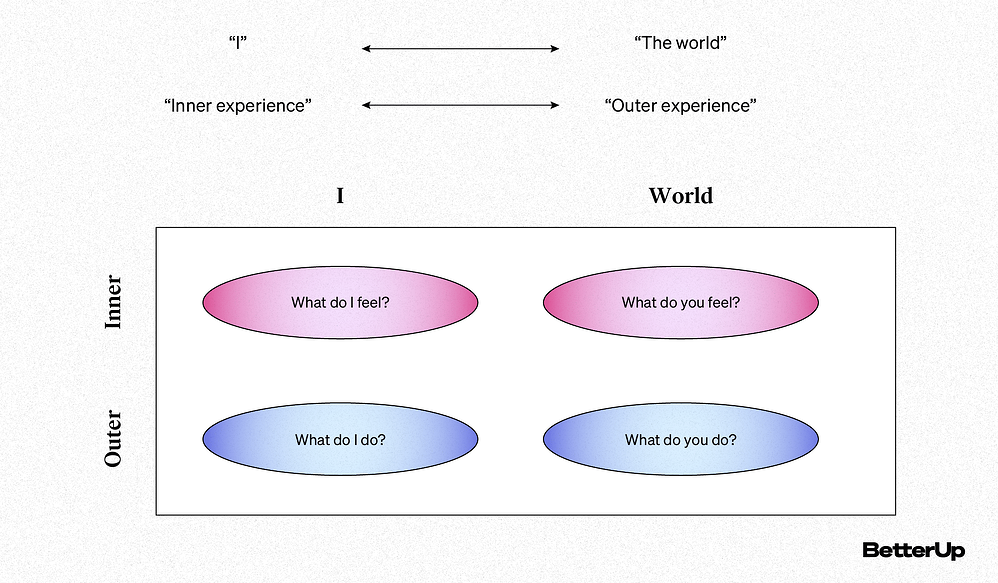
Inner Work® is essential to help people thrive. At a time when only 46.5% of Americans say they’re thriving, it’s more important than ever to begin prioritizing Inner Work®.
Essentially, Inner Work® is the practice of looking inward to our authentic selves and experiences and taking time for the things that ignite our passion, creativity, and innovation. Simply put, the work of Inner Work® starts inside us.
Before we dive into Inner Work®, it helps to understand what the opposite of Inner Work® is: outer work. My understanding of outer work is inspired by E.F. Schumacher’s A Guide for the Perplexed.
Outer work encompasses activities that are external to us. That includes many of our normal work tasks, like sitting in meetings, analyzing data, making presentations, interacting with customers, and even collaborating with teammates.
Outer work consists of acts and activities you engage in to create value outside yourself.
It consists entirely of what you do and what others do. And if you think anything like I used to, you probably think that’s exactly what you’re paid to do.
For the vast majority of professionals, outer work is where they spend the majority of their workday.
In fact, we devote so much time to outer work, we hardly even think about it — and that’s part of the problem. When all our goals are focused on the outer work, we may miss the importance of doing the Inner Work® that helps the outer work succeed.
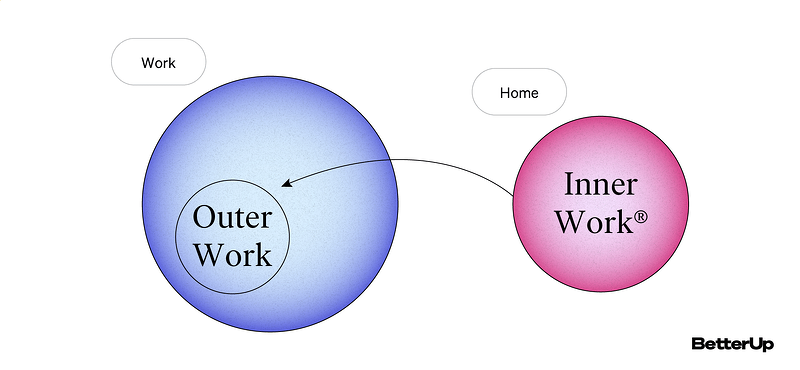
When it comes to making tough decisions, coming up with creative solutions to problems, and being an inspiring leader, outer work only plays a small role.
In a knowledge economy, our daily work is fueled by critical Inner Work®. And there’s a profitable side effect of doing it, which is exponentially elevating the value of our decision-making skills and productivity.
While outer work occupies many of our work hours, we often save Inner Work® for our leisure time ... if we prioritize it at all. Reflecting, journaling, and thinking may seem like part of the “life” side of your work-life balance, but Inner Work® can also make you more effective and impactful in your work life.
Inner Work® explores the inner experiences of yourself and others. Thinking about inner experiences in the context of work is not something we’re accustomed to doing. In many ways, it can be a lot harder to conceptualize than outer work.
There’s a famous slide in Netflix’s culture deck that I’m sure you’ve seen before. It highlights that the best creative work is 10 times better than average, as compared to the best non-creative decision, which is only two times better than average.
The reality is that when we have a ton of outer work to do, it’s difficult to get to that 10x place creatively. That’s because good knowledge work is about how you think, not just what you do. And, how you think isn’t outer work. It’s Inner Work.
Inner Work® can be harder to understand because we don’t have a clear picture of our inner world in the first place. Often, if we haven’t worked with a coach, gone to personal therapy, or delved into our spiritual lives, we may not even realize that there’s Inner Work® to do.
The sphere of outer work is the world outside us. The sphere of Inner Work® is our world inside of us.
Our inner world plays a major role in how we conceptualize and relate to the outer world, but we may not give our existing beliefs or our inner self enough credit for what happens outside of us.
Our inner world encompasses all of the processes, values, and mental models we use to make sense of ourselves and the world around us. Some aspects of our inner world are conscious, while other elements are subconscious or automatic. Our inner world includes decision-making, self-awareness, imagination, and spiritual belief.
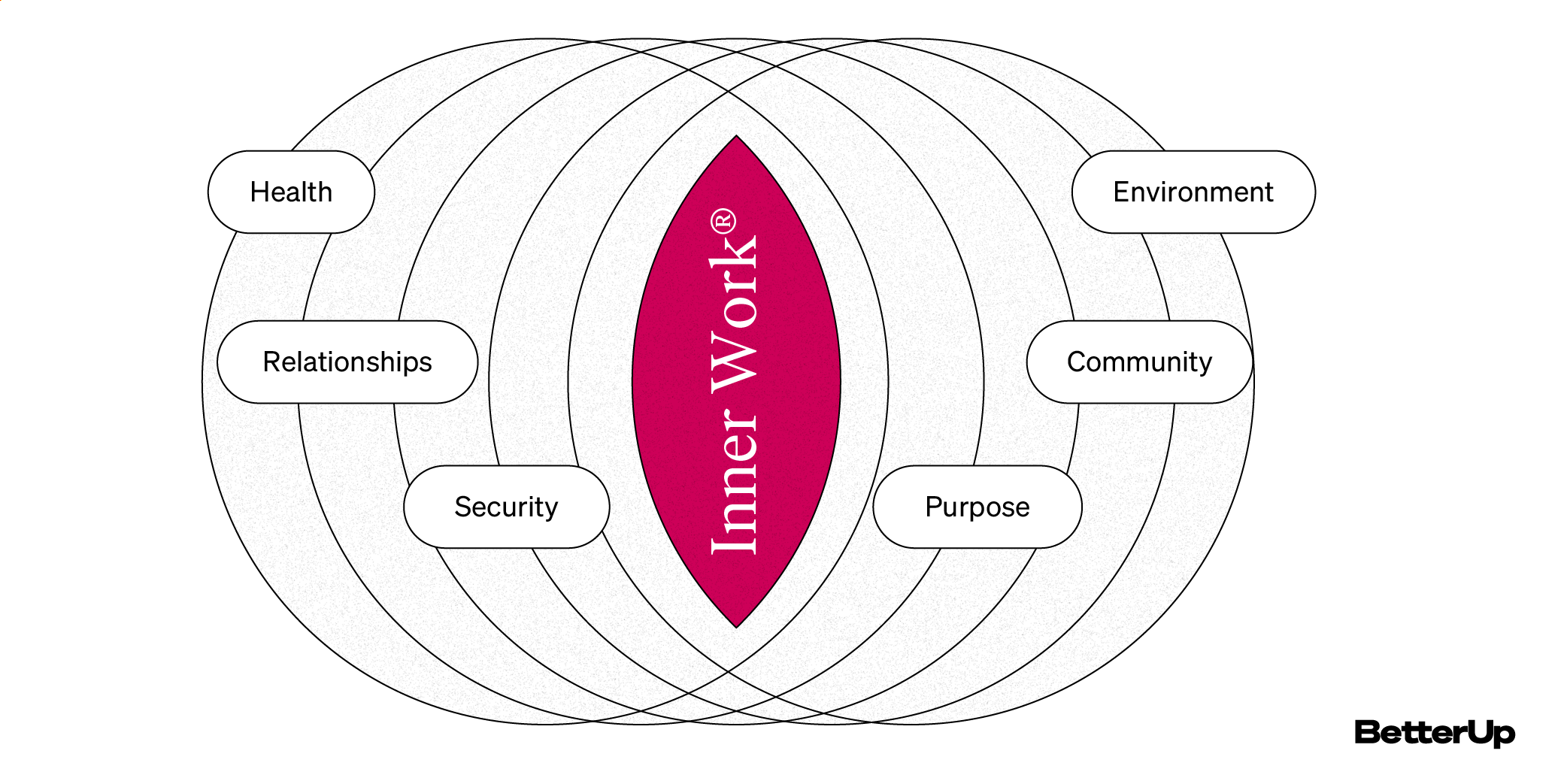
Based on this understanding, Inner Work® consists of:
One thing is for sure: Inner Work® doesn’t feel like work as we know it. If your inner experience is anything like mine, you’ll likely initially feel lazy or even guilty engaging in Inner Work at work.
That doesn’t mean pursuing Inner Work® is easy, effortless, or self-indulgent. In fact, Inner Work® can offer huge benefits for your mental well-being.
Starting to engage in Inner Work® can be daunting, especially as part of your workday. Many of us may not know how to incorporate practices like mindfulness into our work hours. Often, we aren't sure that we should.
While doing Inner Work® may seem counterintuitive, it can have substantial benefits in both your work and home life.
Changing our daily habits at work to recognize the value of rest, of looking inward, and doing work focused on understanding our own potential is key to performing over time. Simply valuing well-being and balance has been shown to foster more positive feelings both at work and at home. That's just the beginning.
Prioritizing well-being is something most of us need to practice, but we can all have more fulfilling and productive workdays.
Simply increasing awareness of our experiences and reflection habits can make a big difference in how we feel at work, interact with our coworkers, and do our work.
Developing your leadership skills and empathy are major drivers to pursue Inner Work. But, there is also a significant link between doing the Inner Work and finding meaning or purpose through work.
You may be surprised to learn just how many benefits you can discover by doing the Inner Work®.
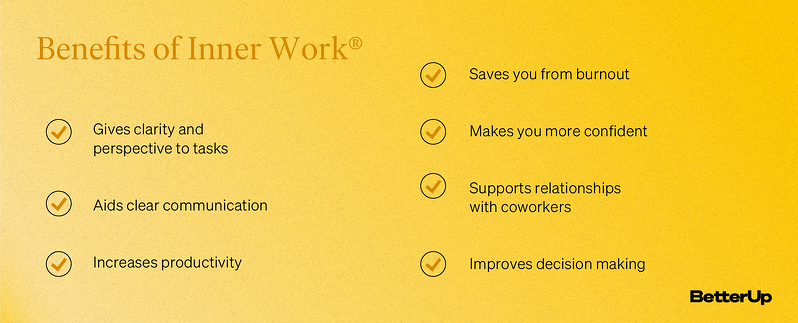
While a better work/life balance may seem tempting, it may not be enough to justify incorporating the Inner Work® in your daily work life. You may still push Inner Work to the wayside when the outer work feels more important.
However, turning inward isn’t just about making you happier or more fulfilled. It can also make you a more effective employee.
Seeing the impacts of Inner Work® on your work output can turn Inner Work® from a "nice to have" to a "must have" during your workday.
Reflection and breathing exercises can help you gain perspective and keep a cool head, even when work gets frustrating.
Taking a moment to reflect on a situation can help you communicate more clearly, be more productive, and foster better relationships with coworkers.
One of the biggest benefits of Inner Work® is reducing burnout. In 2020, over 68% of employees reported feeling burnt out from working at home.
Even while employee engagement soars, many employees are struggling, leading to a higher risk of burnout.
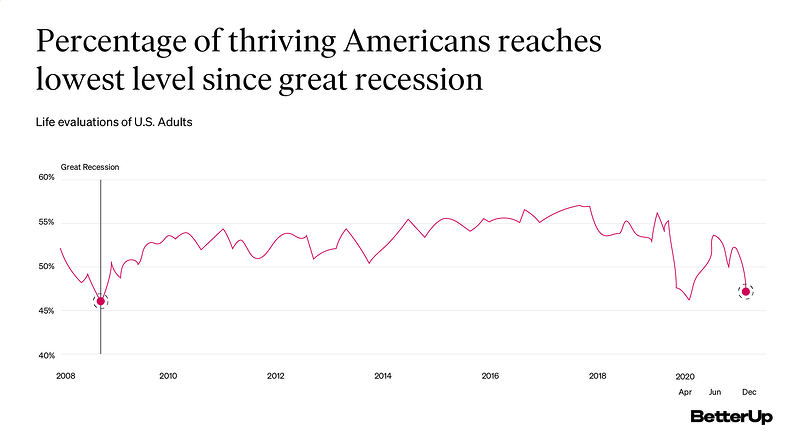
By doing the Inner Work®, you can reduce feelings of burnout, helping you feel happier, more engaged, and more productive.
I’m not the first person to feel guilty engaging in activities other than outer work at work.
It’s an important presupposition in Joseph Pieper’s essay “Leisure: The Basis of Culture.” It’s not surprising that his ideas are gaining newfangled praise and attention in the swirl that is the modern world of work:
The inmost significance of the exaggerated value which is set upon hard work appears to be this: man seems to mistrust everything that is effortless; he can only enjoy, with a good conscience, what he has acquired with toil and trouble; he refuses to have anything as a gift.
Joseph Pieper
It’s important to point out that work wasn't always the exclusive domain of outer work. Before the industrial revolution, people spent a lot of time doing Inner Work® — contemplating, reading, meditating, and just being present with their thoughts and selves.
Admittedly, if you work in a textile factory, Inner Work® likely isn’t moving the needle (no pun intended) on the value you create.
But if you work in the knowledge economy, where creativity and leadership — not routine manual labor — produce value, then Inner Work® is indispensable.
If you take Immelt and Aurelius at their word, it’s what’s most valuable to you as a leader. In fact, it’s the essence of leadership.
We’ve learned that expression of your full self (or, as we’d say at BetterUp, your Whole Person) as a leader comes from a bold journey into yourself to explore your values, what gives your life meaning, and the person you want to be.
Beloved counselor to U.S. presidents, professor to generations of students, and celebrated business thinker Warren Bennis drives the point home when he says:
No leader sets out to be a leader. People set out to live their lives, expressing themselves fully. When that expression is of value, they become leaders. So the point is not to become a leader. The point is to become yourself, to use yourself completely – all your skills, gifts, and energies – in order to make your vision manifest.
Warren Bennis
That’s some real Inner Work®.
Pursuing Inner Work® doesn’t have to be complicated. Even a few minutes a day can help you explore your inner world and see the benefits of doing it.
There's no pre-set way to do this work. Each of us has our own path. We each have to develop our own set of practices that help us make space and facilitate doing the work that brings self-knowledge and exploration. Broadly, though, it is helpful to think of your Inner Work® as three types of activities, each supporting a vital part of your journey. These three categories of activities include: Looking In, Getting Out, and Linking Up.
We're fortunate to be able to draw inspiration and practical guidance from time-tested (and science-supported) practices that people across cultures have done for years. We've listed a few activities to help you get started.
Contemplation
Contemplation is when you engage in reflective thought around a particular subject. Whether you're just pondering or truly grappling with an issue, it allows you to understand how an idea relates to a current challenge you may be facing and your overall value system. It can be both cathartic and enlightening as you discover new ways of being.
Meditation
Engaging both the body and mind in the pursuit of spiritual elevation is a great way to be present with yourself, how you’re feeling (both physically and emotionally), and what you’re thinking. It’s inherently centering and grounding.
Journaling
By recording your thoughts, experiences, and ideas, you can unblock your mind in a variety of ways. From helping you become a better problem solver to clarifying how you approach situations and your own emotional well-being, journaling is one of the easiest ways to create clarity in your mind.
Prayer
Prayer allows you to direct the expression of your thoughts at a higher spiritual being. Praying mindfully searches your heart and mind — allowing you to illuminate your inner thoughts, intentions, and motives.
Time off
There’s nothing quite like stepping away from your day-to-day routine to reconnect with your values, passions, and interests. Taking time to yourself also allows you to re-establish and rediscover where you derive meaning.
Walking
Charles Darwin turned to walking when faced with challenging problems — and with good reason. Physical exercise can help spark creativity and increase concentration. As Darwin found, it also allows the mind to wander to new and unexpected places which can help encourage creativity.
Reading
It's no secret that reading opens your mind to new ways of thinking, encourages your imagination, and reduces stress. Reading allows you to become the narrator of someone else’s story. It also increases your capacity for compassion and empathy, allowing you to explore different experiences and cultures.
White space
Take a page from Marcus Aurelius’ playbook and structure your day in a way that allows you to take a step away from the busyness and collect your thoughts. Block time out on your calendar so you always prioritize this important practice.
Philosophizing
Much like contemplation, philosophizing is a way to broaden your views by pondering deeply about a certain subject. Follow Socrates’ famous example and partner with one or two others to answer big questions through structured dialogue.
Coaching or therapy
The reality is that reconsidering your value system, evaluating internal thought processes, and reflecting on your relationships can be challenging, daunting and even a little exhausting.
Sometimes it helps to talk things out in a safe and confidential space. Enlisting the help of a coach or therapist can provide you with the perspective, feedback, and accountability you need to realize your full potential.
Without Inner Work®, we’re vulnerable to depression, stress, and burnout, and consequently, lower-quality decisions and decreased creative output.
I'd argue that one reason there is so much disengagement or toxicity in the workplace is that people come to work with the expectation that their job is only to do outer work and make no time for Inner Work®. In creative work, the quality of my outer work is greatly impacted by the quality of my Inner Work®.
As leaders, it’s our responsibility to lead the way and guide our teams to engage with the Inner Work®.
As I reflect on episodes in my career where I wasn’t performing at my best as a manager, one common theme is that I lacked the internal clarity around what to prioritize personally and professionally.
We’ve all been there: unanchored, flailing, desperately trying to gain a sense of control, knowing all along that every frantic step we were taking was only further diffusing our impact instead of fastening our footing.
As CEO, I aggressively seek out opportunities to sponsor everyone at BetterUp making “journeys into the interior.” The reality is that when fortified with Inner Work®, our jobs can be one of the most fulfilling parts of our lives.
Work can be a powerful platform to discover new parts of ourselves: interests, capabilities, and opportunities for growth. But capitalizing on these insights requires meaningful reflection. The day-to-day grind can be unrelenting and all-consuming.
What we’re learning at BetterUp is that it’s important to offer helpful nudges, reminding us to step back for a second, turn away from the task at hand, and turn inwards to check in with ourselves.
Here at BetterUp, we routinely share “notes from the interior” to create a community of practice around what good Inner Work® looks like. We also give every BetterUp employee one day every quarter to focus on the Inner Work®.
We don’t expect every organization to give employees a day off to engage in Inner Work®. However, one of the most valuable tools we can give our teams is time to dedicate to the Inner Work®.
As our wise guide, Marcus Aurelius reminds us: “It is in thy power whenever thou shalt choose to retire into thyself.” Devoting just 15 minutes a day to doing Inner Work® can make a huge difference — whether it’s meditation, prayer, reading, or coaching.
The biggest opportunity our world affords us is to reinvent the very concept of work: away from the busyness of our to-dos, and inward toward developing ourselves so that we lead more fulfilling lives outside of work, too.
As a culture, we’ve become obsessed with quantity and speed, but we spend less and less time doing the important Inner Work® required to drive quality and well-being.
It won’t be easy. In fact, it’ll be hard (inner) work, but it will be well worth it.
Part of being a great leader is creating opportunities for your team to grow. Prioritizing the Inner Work® is a great way to get exceptional results from your team while enabling their self-development.
Looking for ways to support your team? Coaching with BetterUp is the perfect way to help your teams dive into the Inner Work® and prioritize their development at work. Sign up today to jumpstart your team’s growth!
Want to join us on our #InnerWork quest? Share your experience using the #InnerWork hashtag on LinkedIn, Facebook, Twitter, and Instagram.
Co-founder & CEO
Products
Solutions
Customers